For most travellers, the best time to visit the Serengeti revolves heavily around the movement of the Great Wildebeest Migration.
However, with all-year-round opportunities for wildlife encounters and lower off-season rates, the Serengeti National Park has so much more to offer. The best time to visit Serengeti will depend on what you hope to gain most from your Serengeti safari.
My wife and I visited the Serengeti and we were fortunate enough to witness the Great Wildebeest Migration from our tent in Asanja Africa Camp.
In this article, I'll share my insights on the best times to visit the Serengeti for an affordable and unforgettable trip.
My Quick Takeaways:
Looking for the best time to go on a trip to the Serengeti? Here’s what you need to know at a glance:
- Best Time for Wildlife Viewing: The dry season (June to October) offers incredible game viewing, as animals gather around water sources and vegetation is sparse.
Great Migration Highlights:
- June to July: Witness the dramatic river crossings as wildebeest and zebras move north.
- January to February: Experience the calving season in the southern Serengeti, with newborns attracting predators.
- Wet Season Perks: From November to May, the landscape is lush, and it’s a fantastic time for birdwatching. However, heavy rains from March to May can make some areas harder to access.
For a full breakdown, check out my complete article! Let's go.
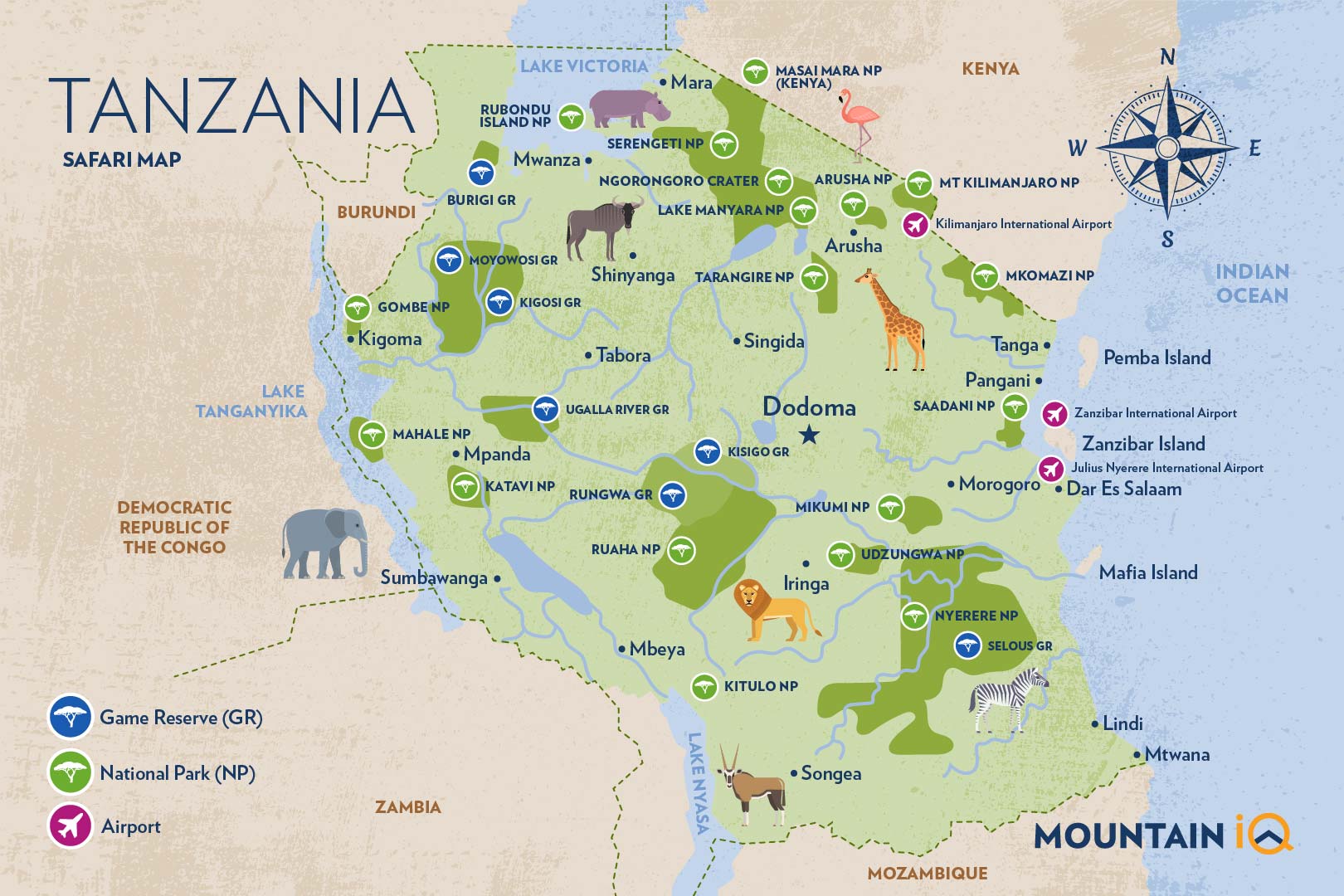
The Serengeti is part of the Northern Circuit and close to other famous national parks like Arusha, Tarangire, Lake Manyara and Ngorongoro.
Before we dive into the Best Times to Visit the Serengeti, it would be a good idea to first orient yourself with my user-friendly map of Tanzania above.
You'll notice that the Serengeti National Park is located in Northern Tanzania and close to the Kenyan border, which could also be an ideal destination for a combined East African safari tour.
Let's crack on!
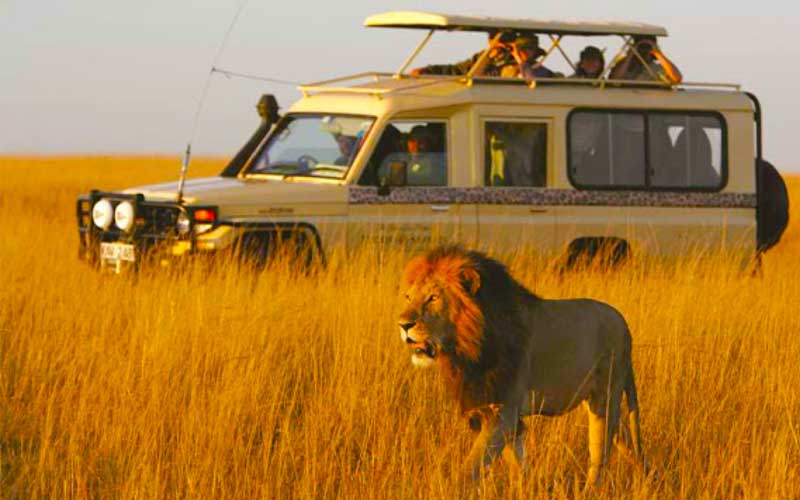
Plan your Safari experience
Check out these amazing deals on epic safari experiences now.
Best Times to Visit the Serengeti
Weather and Seasons in the Serengeti
The weather in the Serengeti is relatively pleasant, reaching temperatures of 25°C (about 77°F) during the day and dropping to 14°C (about 57°F) at night.
My Pro Tip: Make sure that you pack appropriate clothes for a safari so that you are comfortable during your stay.
See more on essential things to pack for a safari in Tanzania.
Safety Tip: To minimise the risk of malaria during the wet season, anti-malaria precautions must be taken. It is highly advised to pack repellent and take the necessary anti-malaria medication.
See my article on vaccinations and medications for more information.
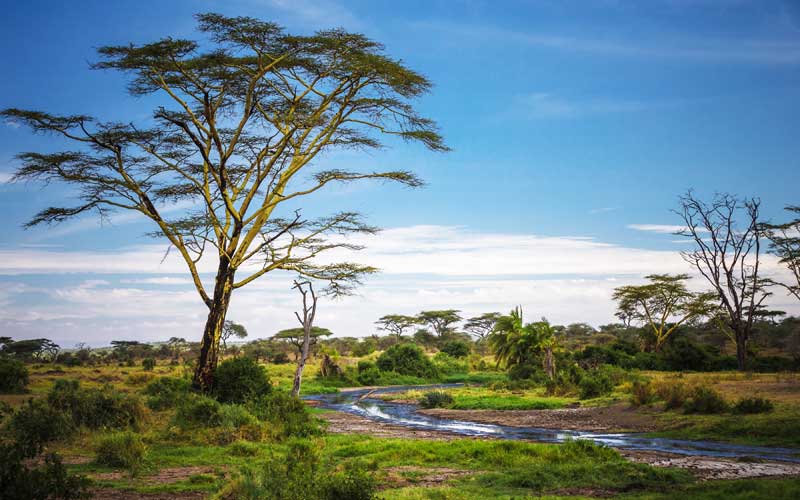
The seasons in the Serengeti National Park are normally classified as follows:
- Dry season
- Wet season
Dry season
The dry season (also known as 'peak season' in travel terms) is from late June to October and is considered the best time to visit the Serengeti overall.
This is because the Serengeti’s rainy periods often make road conditions very poor and restrict access to the plains filled with the wildebeest herds and other wildlife.
Wet season
The wet season in the Serengeti is from November to May and is typically characterised by consistent rain and humidity. This season is further classified into two distinct periods of rainfall:
- Short rains - November to December
- Long rains - March to May
Of course, you can't forget about the third and most important season of all in Tanzania - the peak tourist season, which happens in two key periods:
- January to February - the calving/birthing season for Serengeti wildlife
- June to October - the 'classic safari' period where tourists can enjoy typical safari accommodation and activities like camping and game drives.
Knowing the Serengeti weather and seasons in advance will help you to better prepare for your safari tour.
Which tour? Here are 5 Serengeti safari tours I highly recommend:
- Group Camping Safari that includes Tarangire and Ngorongoro (4 days)
- Budget Serengeti Safari (5 days)
- Scenic Northern Tanzania Safari (7 days)
- Serengeti Trail that includes Ngorongoro (8 days)
- Best of Kenya and Tanzania (incl. 6 national parks) (12 days)
See more Serengeti safari deals.
Here is a quick outline of the characteristics and benefits of various safari seasons in the Serengeti:
Time of year | Weather Conditions | Description |
|---|---|---|
January - February June - October | Jan-Feb generally marks the dry spell between the short and long rains. There is little to no rainfall from June-October, which also makes it part of Serengeti’s dry season. Temperatures reach up to 25°C (77°F) with cold early mornings and evenings. Risk of occasional cold fronts in July when temperatures can reach close to freezing. | Many visitors prefer this over the hot, humid rainy months. Ideal times to go on a classic safari. Spotting wildlife is more predictable during these months as the vegetation thins out and animals gather around waterholes and rivers. Another benefit to consider is that during this time of the year there are fewer mosquitos and a smaller chance of catching malaria. |
March-May | Known as the period of of 'long rains' during the wet season. The weather is extremely hot and humid during this season. | While it may still be a good time to visit Serengeti, your trip will be impacted by the heavy rainfall. Tourists who find these weather conditions unpleasant should ideally avoid travelling during these months. |
November-December | Known as the period of 'short rains' during the wet season. Less predictable rainfall than in the 'long rains' period and lots of afternoon thunderstorms. | The wildebeest herds are drawn back to the Southern grasslands. Safaris are unlikely to be impacted by the weather. Considered an excellent time to visit the Serengeti. |

Plan your Safari experience
Check out these amazing deals on epic safari experiences now.
Best Time to Enjoy an Affordable Safari
A traveller looking to enjoy an affordable Serengeti safari can take advantage of the wet season period from November to May.
This time of year (also known as the off-peak 'green season' for its lush vegetation) typically herds in (pun intended) the best deals and discounts.
If you can brave the rain, you'll benefit from these off-peak seasonal rewards:
- A cheaper safari
- Fewer crowds
A Cheaper Safari
While the dry season is considered the best time to visit the Serengeti, visitors who brave the wet season (November-May) have the advantage of reduced accommodation prices and a better safari.
Serengeti safaris offer spectacular wildlife viewing throughout the year, and fewer tourists usher in discounted safari rates and the opportunity to stay at lodges that would have otherwise been unaffordable.
Fewer Crowds
For experienced safari-goers, a major draw-card of the off-peak Serengeti season is fewer crowds. This means that you don’t have to navigate through the peak-season crowds, especially in April and May.
It might come as a surprise to discover that some tourists plan a trip to the Serengeti to avoid the Great Migration altogether.
The Serengeti National Park has so much more to offer beyond the great wildebeest trek.
Read on for more detailed info on the best times to visit the Serengeti for specific safari tours and activities.
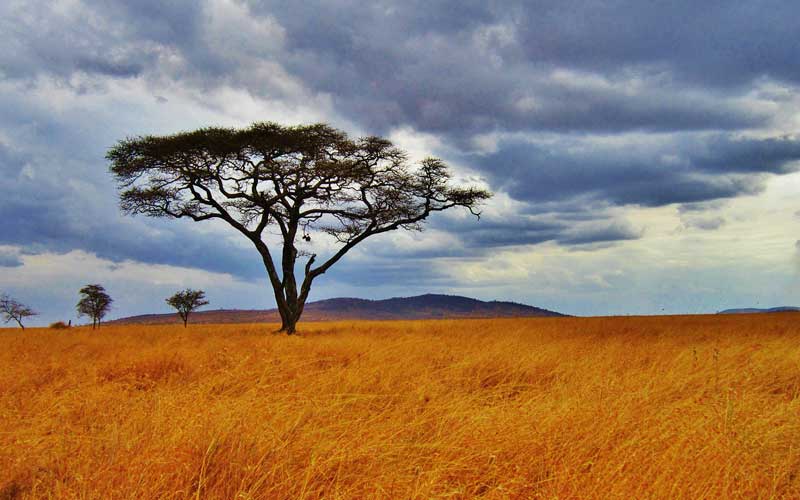
Acacia tree in the Serengeti Plains
Best Times for Serengeti Safaris during the Great Wildebeest Migration Seasons
The best time to go on a Serengeti safari is late January and February for the calving season and from June till September for the Great Wildebeest Migration as well as a great classic safari. But these are also the most popular and touristy months.
The less crowded and cheaper period is from November till May, known as the Green Season.
In general, the wildebeest migration tends to be in the Southern Serengeti for the calving season from February to mid-March.
At the same time, during the period between December and March, the herds head out in the direction of the Ngorongoro Crater.
For someone who finds the wildebeest calving period fascinating and jumps at the chance of unprecedented predator action sightings, then late January-February would be the ideal time for a Serengeti safari.
Overall, the best months to see the migration are from June-September as animals concentrate around watering holes and rivers.
During these months, you might be able to catch the herds crossing the Grumeti River or Mara River.
Understanding the pattern of the Great Migration will help you choose the best time of year to visit the Serengeti.
Below is a map outlining the wildebeest migration schedule:
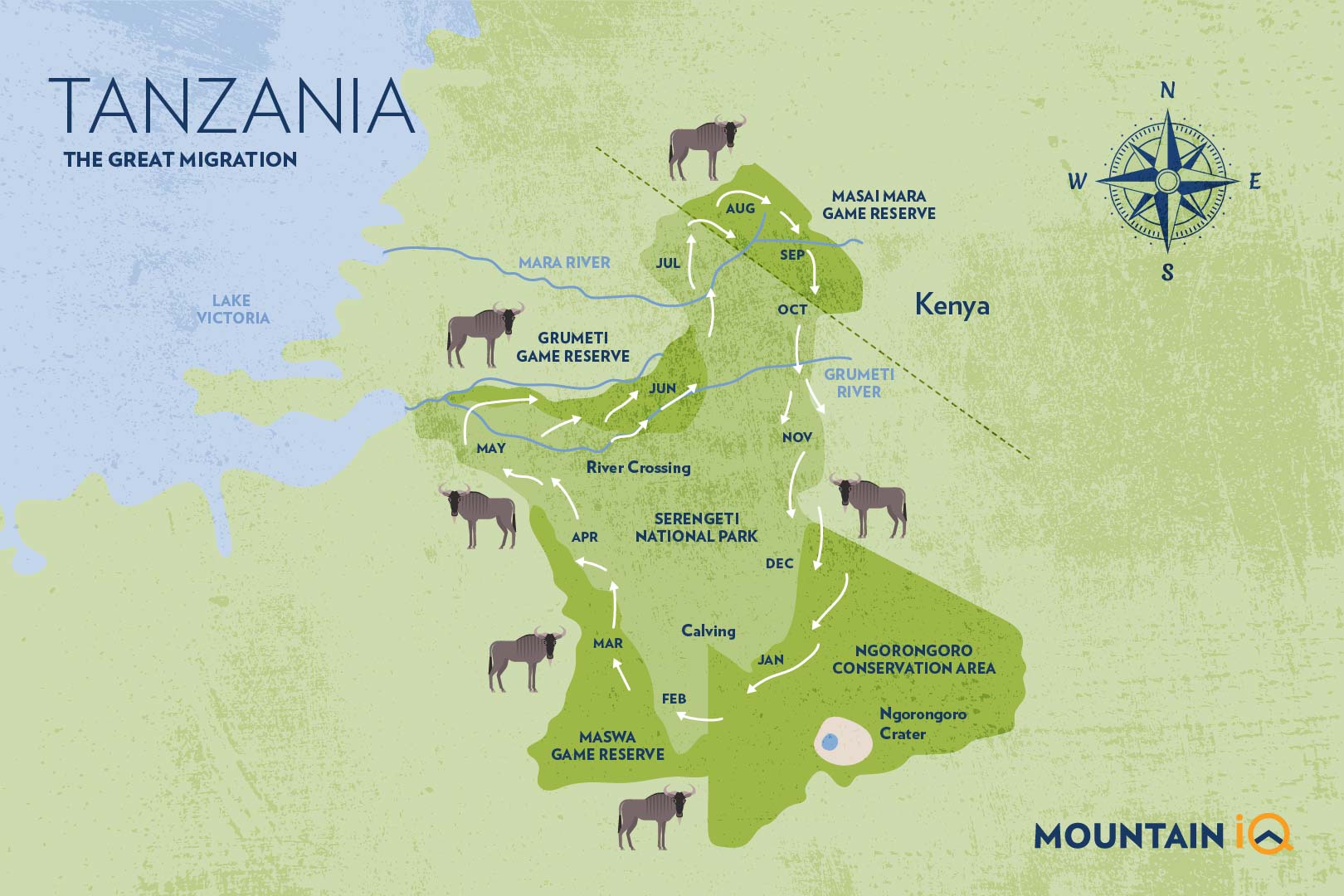
The Great Wildebeest Migration River Crossing in Serengeti
Calving Season – Late January till February
As the migration slows down, this period not only offers a chance to witness the wildebeest drop their young but also brings with it an unprecedented opportunity for predator action sightings as lurking big cats look to strike when the herds are most vulnerable.
For experienced safari travellers, the calving season is probably the best time of year for intensified wildlife encounters with baby wildebeest, cheetah cubs, elephant calves and more.
The movement of the herds is most predictable during this time.
In pursuit of fresh, lush plains, the herds then head out north. This period gives travellers the chance to witness around 1.7 million wildebeest and countless herds of other kinds of antelope trek across part of their 800 km journey.
Generally, April-May is regarded as the low season when conditions are least favourable for wildlife viewing.
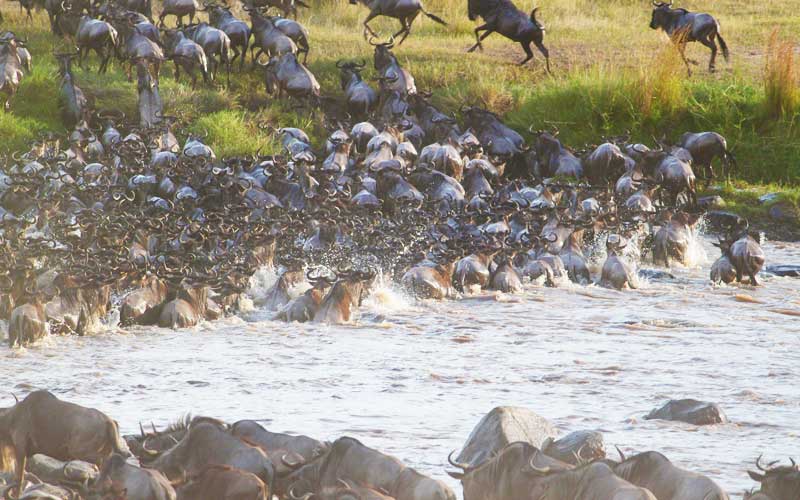
The Great Wildebeest Migration River Crossing in Serengeti
Wildebeest River Crossing – June-September
From June-July, it’s easier to spot the herds in the park’s Western Corridor, as they gather near the Grumeti River.
From August-September, the grazers move into the Northern Serengeti and Kenya’s Masai Mara National Reserve.
During this season, you have the chance of witnessing the famous river crossings across the crocodile-infested Grumeti River from June to July, and the Mara River from August to September as they cross into Kenya.
The sweeping herds then head back down to the Southern Serengeti, and the cycle starts again.
Where to stay? Here are 5 of my favourite accommodation options in the Serengeti:
- Africa Safari Serengeti Ikoma
- Serengeti Serena Safari Lodge
- Ole Serai Luxury Camp
- Asanja Africa
- Melia Serengeti Lodge
See more Serengeti accommodation options.
Best Time to see Migratory Birds in the Serengeti
Experienced birdwatchers find that November-April is the best time of year to visit the Serengeti as European and North African migratory bird species make this landscape their winter home.
Read more about bird species you can view in the Serengeti.
Great Birdwatching
Bird watching enthusiasts will be delighted to discover that the Serengeti is home to more than 500 bird species, five of which are found nowhere else on earth.
While bird watching is considered to be good all year round, the ideal season is from November-April. During this time European and North African migratory bird species make the Serengeti their home.
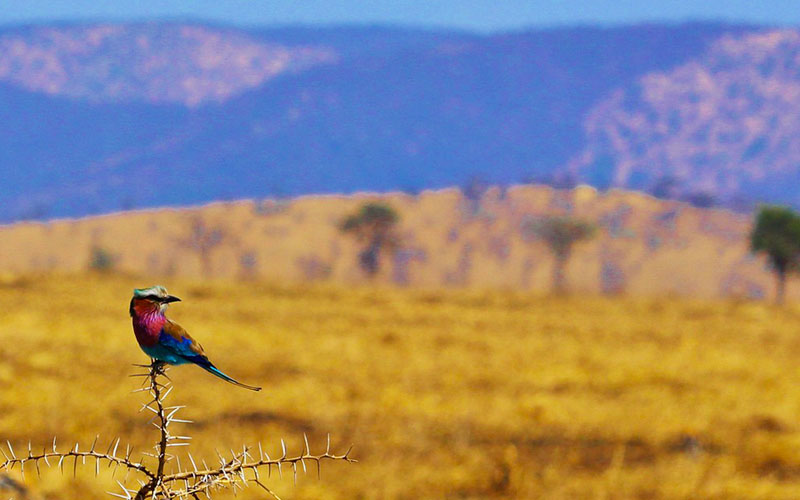
My Final Thoughts
I hope this article helped you figure out the best times to visit the enduring plains and grasslands of the Serengeti. All that's left to do is plan and prepare for your most ideal and affordable Tanzanian safari. Let me know when you're going on your trip. Happy travels!
